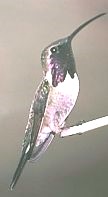Lucifer Hummingbird is a Mexican species whose range just reaches Texas, Arizona and New Mexico. It can be distinguished from other medium-sized hummingbirds by its relatively long, decurved, black bill and the male’s iridescent purple gorget. (Scott 1994, Pyle 1997).
The male’s courtship display is also diagnostic (see Fig. 3 in Scott 1994). The male displays at the nest site while the female is building it, laying eggs and incubating and when nestlings are present, although he does not assist with building the nest or feeding the young (Scott 1994).
DISTRIBUTION. During the 1987-1992 field work for the TBBA project, observers found 2 confirmed breeding sites for Lucifer Hummingbirds in latilong blocks 29103 (Big Bend National Park) and 30104. They also found a possible site in 29103. Lockwood and Freeman (2004) rate the species as a locally common summer resident in the Chisos Mountains, and rare and local in the Davis Mountains with scattered records elsewhere in the Trans-Pecos region.
Elsewhere this hummingbird breeds in southeast Arizona, southwest New Mexico, south through the highlands to central Mexico. The species winters on the Pacific slope from central Mexico to Oaxaca (Scott 1994, Howell and Webb 1995, Corman 2005).
SEASONAL OCCURRENCE. Lucifer Hummingbirds have been reported in Texas from March 7 to November 10 with breeding evidence found May 18, July 13 and early August (Oberholser 1974). Breeding may start as early as mid-April in years when good supplies of nectar are available and females may raise two broods. In other years breeding is delayed until June after the summer rains start. (Scott 1994)
BREEDING HABITAT. Nesting of Lucifer Hummingbird in Texas has been observed as low as 810 m (2720 ft) and as high as 1500 m (5000 ft; Oberholser 1974).
In Arizona this hummingbird breeds in a variety of habitats, cottonwood-willow riparian, dry washes with mesquite and palo verde, evergreen oak and semiarid grassland with sotols and agaves (Corman 2005). In Texas nests have been found on horizontal stems of cane cholla, leafy stems of ocotillo or dead lechuguilla stalks, 0.5-3 m (2-10 ft) above ground. The nest is built of soft materials bound together with spider silk and often camouflaged with lichens (Harrison 1979, Scott 1994, Corman 2005).
The female lays 2 white eggs, 2 days apart, indistinguishable from those of other similar- sized hummingbirds. She incubates for about 15 days. The young birds leave the nest 19-23 days after hatching and are fed near the nest by the female for 13-19 days afterward (Harrison 1979, Scott 1994).
STATUS. Scott (1994) reported that the population had been present in Texas for at least 90 years and estimated its size at about 200 individuals. Population trend data is not available since the Breeding Bird Survey does not sample this species in the United States, but the survival of a population of this size is always questionable.
Text by Robert C. Tweit (2006)
Literature cited.
Corman, T. E. 2005. Lucifer Hummingbird (Calothorax lucifer). In Arizona breeding bird atlas. pp.254-255 (T. E. Corman and C. Wise-Gervais, eds.), University of New Mexico Press, Albuquerque.
Harrison, H. H. 1979. A field guide to western birds’ nests. Houghton Mifflin, Boston, MA.
Howell, S. N. G. and S. Webb. 1995. A guide to the birds of Mexico and northern Central America. Oxford University Press, New York.
Lockwood, M. W. and B. Freeman. 2004. The TOS handbook of Texas birds. Texas A&M University Press, College Station.
Oberholser, H. C. 1974. The bird life of Texas. Vol. 1. University of Texas Press, Austin.
Pyle, P. 1997. Identification guide to North American birds, part 1. Slate Creek Press, Bolinas, CA.
Scott. P. E. 1994. Lucifer Hummingbird (Calothorax lucifer). In The birds of North America, No. 134 (A. Poole and F. Gill, eds.). The Birds of North America, Inc., Philadelphia, PA.

